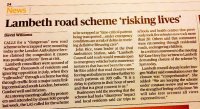Let's summarise what we had:
1.) An Ambulance Service Team Leader, responsible for one of three entire shifts, represented the ambulance service and spend his 5 minutes at the meeting lambasting the LTN He gave information fed back from the Oval Service as a whole. Congestion, traffic, delays, barriers. He did this in a room full of residents, business owners and - importantly - local press. He knew he was a spokesman for Oval Ambulance Service. He introduced himself as such - I was one of the few hundred in the room.
In addition he said it was difficult for them to quantify exact measurements because they would need a dedicated team to analyse the routes, typical response times and other factors. The Fire Brigade (not present at the meeting) said similar - gridlock, not enough time to measure (the 8 week period does seem pretty important BUT they all said despite the measurement difficulties they were confident giving such feedback.)
2.) Figures from the Ambulance Service in which they say delays of 1-2 minutes were seen which is an average increase of up to 30% on an emergency call out times.
Just because they did not formally object does not make the impact evidence and their statements any less relevant



